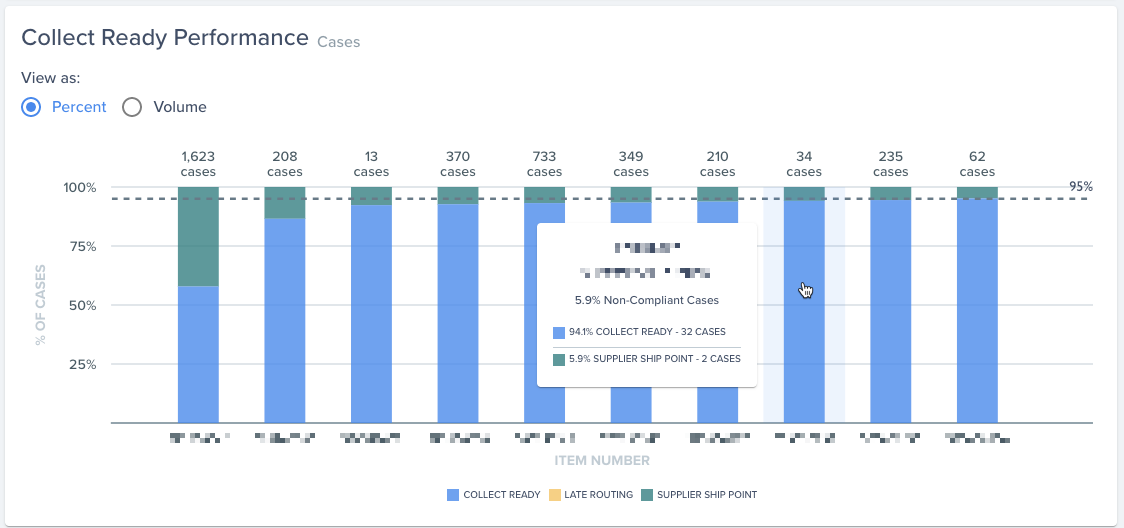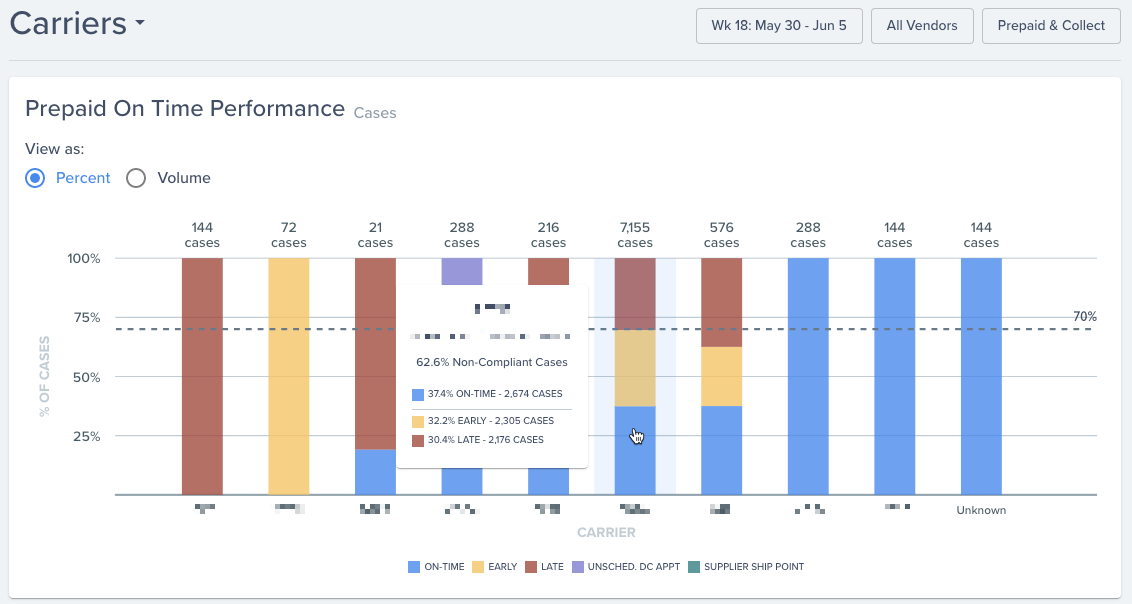Should I Use Prepaid or Collect Freight?
Learn about:
- The differences between Prepaid and Collect Freight
- The changes in Walmart OTIF goals for each
- The pros and cons of Prepaid versus Collect
How should you get your product on the shelf? There are many options for freight these days. Third-party logistics companies (3PLs) offer full truckload shipping, less than truckload, and even a blended mix between the two. Some customers, such as Walmart and UNFI, will even arrange to come and pick up your orders from your warehouses. So which option is right for you?
The National Motor Freight Classification (NMFC) has defined two categories of freight as “Prepaid” and “Collect”. Note that these are expressions of transportation, not billing. So, you wouldn’t necessarily demand payment in advance for an order that is Prepaid freight, and Collect shipments are not necessarily invoiced upon delivery. These terms simply indicate who is liable to the transportation company.
What is Prepaid freight?
Prepaid freight or Prepaid shipping simply means that you are responsible for arranging the terms and conditions of getting your products to the stores or distribution centers. In other words, you must decide the means of delivery to your customers, and you manage all the logistics (unless you hire a 3PL to do that for you).
When you use Prepaid freight, you pay for the carrier or 3PL charges and, presumably, incorporate that cost into your invoices or supplier agreements for your customer. In addition to transportation charges, 3PLs and carriers may also charge for “accessorial services,” for which you will also be responsible.
Prepaid freight comes in two different forms: less-than-truckload (LTL) and full truckload (FTL).
Related Reading: LTL and FTL Shipping: Which is Best for You?
What is Collect freight?
Collect freight shipping refers to shipments where the customer pays for all transportation fees and charges, including accessorial and related fees. You are in charge of getting your orders ready for pick up, not for paying for transportation.
Collect orders either refer to instances where the customer uses its own transportation to retrieve your order, or where the customer uses a third-party carrier. Either way, it is the responsibility of the customer to pay for transportation costs.
What are the pros and cons of Prepaid freight? What are the pros and cons of Collect freight?
Before you sign anything with your buyer, you’ll want to weigh your options. Here are the pros and cons of Prepaid versus Collect freight.
Pros of Prepaid freight
You are in control. It’s your freight, your responsibility, your choice. You manage the carriers and determine which order goes on what truck. There is a vast selection of carriers to choose from, and you can judge for yourself which one is best for you. This wide selection allows you to negotiate and renegotiate your carrier terms and costs.
Alternatively, you can utilize a 3PL or consolidator and let them do the work. Doing so also gives you lots of choices, as there are plenty of logistics companies competing with each other for your business. These companies will fight for you to make sure you have the best transportation at the lowest price. If you use a third-party warehouse, it likely has transportation management solutions as well.
You determine the cost of shipping and pass it on to your customers. As the liability of freight costs lies on your shoulders, you can negotiate how much your customers pay for orders. This gives you an opportunity to increase your profits.
Cons of Prepaid freight
It’s all on you. If the truck doesn’t reach the DC on time, you’ll be the one stuck with the fine. You have to ensure that your 3PLs and carriers make good on getting the order within the different Must Arrive By Dates (MABDs) listed on each purchase order. Otherwise, failures to complete orders within the delivery window will result in fines and fees to you, not your third parties.
You have to be very selective about your logistics and consolidators. You can’t afford to employ a carrier who is late (or even early) all the time. You have to research your options very carefully across tens of thousands of carriers, 3PLs, or consolidators.
You have to constantly monitor performance. You may do this by creating your own logistics department dedicated to selecting carriers and negotiating with them, which may increase your overhead and decrease your profits. Even if you hire a 3PL, you will still need to stay on top of their performance to ensure compliance and hold them accountable.
Pros of Collect freight
You’re not responsible for poor delivery performance. Your responsibility is to ensure that your orders are complete and ready for shipment by the appointment time on your PO (which you should be doing anyway to comply with In-Full goals). This can mean fewer compliance issues, and therefore, fewer fines. Additionally, you can find compliance pain points more easily.
You offload the work onto your customer. Because you are not in charge of shipping, your customer does all the work. This means fewer resources dedicated to making sure orders arrive on time and means fewer employees and less overhead.
Transportation costs do not fluctuate. Negotiating and renegotiating freight terms can be tiresome and costly. You must do diligent research constantly to ensure you get the most bang for your buck. On the other hand, with Collect freight, you lock in your transportation terms with your customers often annually, removing unknown variables in shipping costs.
Cons of Collect freight
You are not in control. Not controlling the freight means you’re not controlling the costs, the shipping times, the carriers, compliance, etc. No control means you can’t negotiate better or cheaper terms and you have less visibility into your supply chain.
Your customers will subtract the costs of transportation from what they pay you. Typically, you’ll only be able to negotiate terms once a year, so your customers will have you locked into specific shipping costs even if there are cheaper options. Additionally, you’ll have to make allowances on your invoices, which can also impact your bottom line.
You lose control of on-time deliveries. You may only be responsible for ensuring that your orders are ready, but you have zero control over when they arrive with Collect freight. Customers have stringent compliance goals for you shipping on time, but they often do not hold themselves to the same standards. Loss of control can impact your instocks and on-shelf availability, meaning lost sales.
The bottom line: Walmart OTIF goals
If you’re a Walmart supplier, you should be familiar with its On-Time In-Full (OTIF) program, but did you know that Walmart recently made significant changes to its OTIF goals?
Previously, Walmart would weigh Prepaid and Collect orders differently. Now, Collect Ready goals are all 98%, and Prepaid On-Time goals are also 98%, even for different types of freight. You no longer can just run the numbers. You have to weigh each option carefully and figure out what you as a supplier can do.
Failure to comply can result in hefty fines. Walmart specifically levies fees of 3% of the cost of goods sold (COGS) for cases that fail to adhere to its compliance goals. Walmart is very serious about receiving its orders on time and in full.
Choose wisely
You need deep, probing insights into your performance. Finding exact pain points in your supply chain is crucial to compliance and avoiding fees. Whether Prepaid or Collect, you’ll need to analyze your orders’ journeys to the stores. SupplyPike can help.
With SupplyPike, you’ll get easy-to-digest trends and analyses into your OTIF performance. View trend graphs, at-a-glance KPIs, and drill-down analytics of your compliance, whether you use Prepaid, Collect, or a mixture of both.
Carrier Analysis – Prepaid On Time Performance

Related Resources
Written by The SupplyPike Team
About The SupplyPike Team
SupplyPike builds software to help retail suppliers fight deductions, meet compliance standards, and dig down to root cause issues in their supply chain.
Read More
About

SupplyPike helps you fight deductions, increase in-stocks, and meet OTIF goals in the built-for-you platform, powered by machine learning.
View SupplyPike's Website
